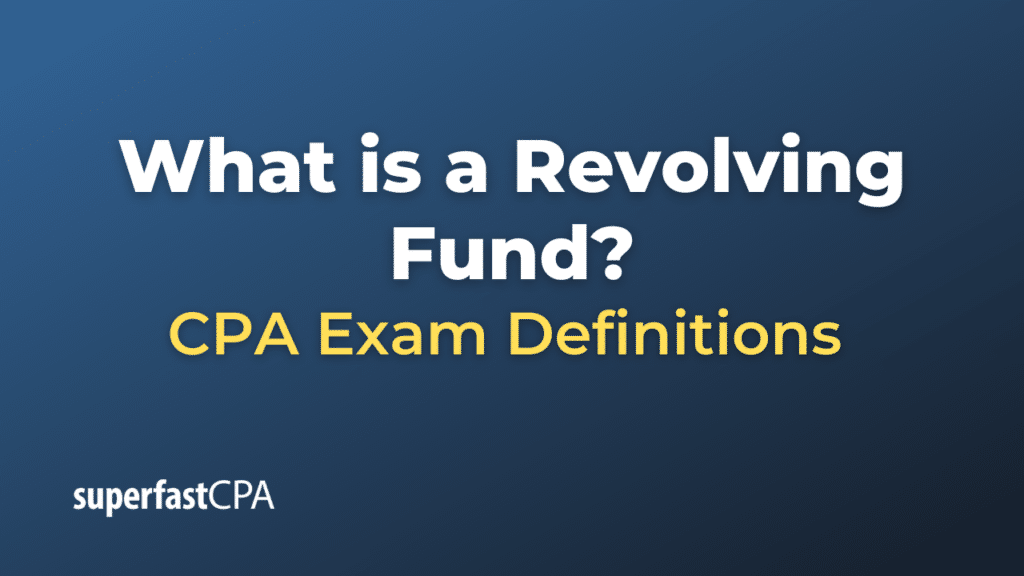Revolving Fund
A revolving fund is a financing mechanism that allows for the continuous replenishment and recycling of funds. It is established to finance a continuous cycle of operations or activities where the money spent will be returned to the fund over time. The returning or revolving nature of the funds ensures that the pool of resources remains available for future activities.
Key features and characteristics of a revolving fund:
- Self-Sustaining: One of the main goals of a revolving fund is that it becomes self-sustaining over time. Money loaned out or spent is eventually returned to the fund, either from repayments, cost recoveries, or other revenues.
- Specific Purpose: Revolving funds are typically set up for a specific purpose, often tied to specific projects or objectives. For instance, a revolving fund might be established to finance small business loans, energy efficiency projects, or affordable housing initiatives.
- Initial Capitalization: The fund usually starts with an initial capital infusion, which can come from government allocations, grants, donations, or other sources.
- Returns: As recipients repay loans or as projects generate revenue, the money is returned to the fund. The rate of return and time frame can vary depending on the nature of the projects and terms of the financing.
- Operating Expenses: In some cases, a small portion of the returns might be used to cover the operational or administrative expenses of managing the fund.
- Flexibility: Depending on its design, revolving funds can adapt to changing needs or circumstances, redirecting resources as needed to meet its objectives.
Examples of Revolving Funds:
- Microfinance Institutions: Many microfinance institutions operate like revolving funds. They provide small loans to entrepreneurs. As these loans are repaid, the money is loaned out again to new borrowers.
- Energy Efficiency Funds: Some governments or institutions set up revolving funds to finance energy efficiency upgrades. For instance, a homeowner might receive a loan from the fund to install solar panels. As the homeowner saves money on their electricity bill and repays the loan, the money returns to the fund and can be loaned out again to another homeowner.
- Environmental Restoration Funds: These might be set up to fund projects that restore damaged ecosystems. As the projects generate revenue (e.g., through sustainable timber harvesting or ecotourism), the money is returned to the fund for future restoration projects.
- Affordable Housing Funds: A municipality might establish a revolving fund to help finance affordable housing projects. As residents pay rent or mortgages, the revenues return to the fund, enabling more housing projects in the future.
In essence, revolving funds are a mechanism to ensure sustainability and continuity of funding for projects or objectives that have a revenue-generating component or a repayment structure. They are particularly useful in areas where consistent funding is required over the long term.
Example of a Revolving Fund
The Green City Council wants to promote energy efficiency and reduce the city’s carbon footprint. They decide to set up an “Energy Efficiency Revolving Fund” (EERF) to help homeowners upgrade their homes to be more energy-efficient.
Setup:
- Initial Capitalization: The city allocates $1 million from its budget to start the EERF.
- Objective: The fund aims to finance energy-efficient upgrades, such as installing insulation, replacing old windows, and setting up solar panels.
- Loan Terms: Homeowners can borrow from the EERF at a very low interest rate, let’s say 2%, and have ten years to repay the loan.
Implementation:
- First Project: Mr. Smith, a homeowner, wants to install solar panels that cost $20,000. He approaches the EERF and receives the full amount as a loan.
- Repayment: After the installation, Mr. Smith’s electricity bills drop by $150 per month due to the solar panels. He decides to pay $200 per month to the EERF. This amount covers his savings and some additional money to repay the loan faster.
- Return to the Fund: As Mr. Smith makes his payments, the money returns to the EERF. Over ten years, the fund will not only get back the original $20,000 but will also earn a small amount of interest.
Expansion:
- Re-loaning: As homeowners like Mr. Smith repay their loans, the EERF has more funds available to loan out to other homeowners.
- Increasing Impact: Over time, more and more homeowners can benefit from the fund. The continual return of the principal along with the interest allows the fund to sustain itself and even grow.
- Administration: A small portion of the interest earned could be used to cover the administrative costs of running the EERF, ensuring it operates smoothly without depleting its principal.
Outcome:
After a decade, numerous homeowners in Green City have taken advantage of the EERF. Many homes are now energy-efficient, the city’s carbon footprint has decreased, and the fund still has a significant amount of money (or even more due to the interest earned) that can continue to be used for new energy projects.
The EERF becomes a shining example of how a revolving fund can have a lasting impact by continually recycling its resources for the betterment of the community.
This revolving fund example illustrates how initial seed money can have a multiplied impact over time when structured in a way that promotes sustainable use and replenishment of the funds.













